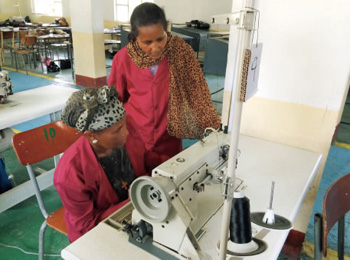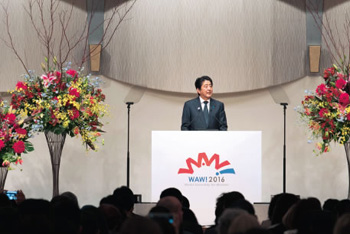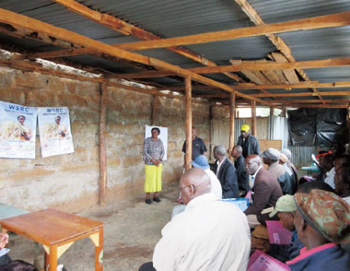(5) Promotion of Women’s Empowerment and Participation
Generally, conventional wisdom and social systems in developing countries are often shaped based on men’s perceptions, making women prone to vulnerable situations in various ways. Compared to the early 2000s when the MDGs were established, girls’ enrolment rate has improved considerably, women’s political participation has increased, and more women hold senior government official and ministerial posts. (Note 20) However, there are still many countries and regions where women continue to lack the same opportunities as men to participate in decision-making processes, which are not restricted to high-level government decision-making but also include family and other private decision-making that affects the lives of women.
Women are critical actors of development, and their participation will lead to not only the improvement of their own lives but also to more effective development. For example, improving the ability to read and write of women who had little or no educational opportunities increases their access to correct information about public health and prevention of infectious diseases such as HIV/AIDS. This leads to voluntary family planning, and to the promotion of women’s social advancement and economic empowerment.
Goal 5 of the SDGs in the 2030 Agenda seeks to “Achieve gender equality and empower all women and girls.” Gender (socially and culturally constructed roles) equality, promoting women’s empowerment, and mainstreaming women’s empowerment in development (gender mainstreaming) are essential for realizing “quality growth.” For this purpose, it is important for men and women to participate equally in development and to equally reap the benefits.
<Japan’s Efforts>
With the understanding that women being able to reach their full potential gives vitality to the entire society and is essential for growth, Japan is advancing its cooperation with the international community towards realizing “a society where women shine.” The Development Cooperation Charter (decided by the Cabinet in February 2015) stipulates giving priority to efforts for “quality growth” and poverty eradication, etc. through such growth based on the human security approach. Furthermore, the Charter clearly states that Japan will encourage the participation of women at every phase of development cooperation and be more proactive in ensuring that women share equitably in the fruits of development.
In September 2013, Prime Minister Abe revealed his plan to strengthen support for realizing “a society where women shine” in his address at the 68th Session of the UN General Assembly. Specifically, the Prime Minister announced that based on the three pillars of “facilitating women’s active role/participation in society and women’s empowerment,” “enhancing Japan’s efforts in the area of women’s healthcare as a part of its strategy on global health diplomacy,” and “supporting women’s participation and protecting their rights in the area of peace and security,” Japan would implement ODA in excess of $3 billion over the three years from 2013 to 2015 and has fully implemented its commitment.

Women attend a leather production training session to gain employable skills near the capital of Ethiopia. (Photo: Ayako Okawa / Embassy of Japan in Ethiopia)

Prime Minister Shinzo Abe delivers his keynote speech at the open forum of WAW! 2016 held in Tokyo in December 2016.
In September 2014, Japan hosted the first World Assembly for Women (WAW!) as part of the efforts to realize “a society where women shine,” one of the Abe Administration’s top priorities. Japan hosted WAW! 2015, for the second time, in August 2015, in which 145 Japanese and overseas leaders active in women-related fields participated. At WAW!2015, following the example of WAW!2014, the ideas and proposals from the participants were compiled and published as “WAW! To Do 2015” (UN document: A/C.3/70/3).
In December 2016 Japan held WAW! 2016, for the third time, and the participants discussed a wide range of issues such as “work-style reforms,” the active role of women in the STEM (science, technology, engineering, and mathematics) fields, women’s well-being, etc. and shared the view that they would steadily move to action. Furthermore, Prime Minister Abe, in his speech at WAW! 2016, expressed that Japan would steadily implement over $3 billion in total assistance until 2018, focusing on respect for women’s human rights, improving an enabling environment for women to realize their full potential, and advancing women’s leadership.
Japan has been extending its assistance through the United Nations Entity for Gender Equality and the Empowerment of Women (UN Women) founded in 2011 by merging four parts of the UN system. In 2016, Japan provided approximately $30 million and contributed to its efforts for women’s political participation, economic empowerment, eliminating violence against women and girls, strengthening women’s roles in the fields of peace and security, and seeking to ensure gender consideration in policy and budgets.
In September 2016 Prime Minister Abe attended the meeting for the HeForShe Campaign (Note 21) by UN Women and emphasized the accomplishments in women’s issues at the G7 Ise-Shima Summit and the value of the World Assembly for Women (WAW!). He also expressed his determination to further accelerate promotion of gender equality and women’s empowerment, and called on each participant to make efforts towards realizing “a society where women shine.”
Japan considers sexual violence in conflict as an issue that cannot be overlooked. In this regard, Japan attaches importance to collaborating with the UN Office of the Special Representative of the Secretary-General on Sexual Violence in Conflict (SRSG) and contributed $2.7 million to the office in FY2015.
When then U.S. First Lady Michelle Obama visited Japan in March 2015, First Lady Akie Abe and Mrs. Obama announced that over ¥42 billion of ODA would be implemented over the three years from 2015 for the empowerment of girls and women and gender sensitive education.
In September 2015, in his address to the UN General Assembly, Prime Minister Abe announced the completion of Japan’s National Action Plan on Women, Peace and Security regarding UN Security Council Resolution 1325. The Prime Minister also mentioned WAW!2015 in 2015, and expressed Japan’s commitment to lead the empowerment of women and expanding their active roles.
Promotion of active roles of women was also largely discussed at the G7 Ise-Shima Summit held in May 2016. Under the recognition that bringing out the potential of women and promoting the participation of women in the field of natural science are important, the G7 leaders agreed to the “G7 Guiding Principles for Capacity Building of Women and Girls” and the “Women’s Initiative in Developing STEM Career (WINDS).” Furthermore, Japan took this opportunity to announce the “Development Strategy for Gender Equality and Women’s Empowerment,” a new strategy for promoting women’s empowerment in international cooperation taking into account the SDGs and the priority areas in the Development Cooperation Charter, and announced that it would implement human resources development of approximately 5,000 women officials and improvement of learning environment for approximately 50,000 girls over the next three years from 2016 to 2018.
Based on the recognition of the power of women as the source of growth, the Development Strategy for Gender Equality and Women’s Empowerment stipulates the fields of priority such as promoting respect for women and girls’ rights, improving an enabling environment for women to reach their full potential, and advancing women’s leadership. Specifically, through development of gender-sensitive infrastructure, support for girls’ education (including Science, Technology, Engineering and Mathematics: STEM), advancing women’s participation and leadership, particularly in disaster risk reduction, etc. Japan aims to support the development of environments and establish institutions that enable women to expand their own options in their lives and independently and freely pursue their possibilities.
- Note 20: Source: “The Millennium Development Goals Report 2015”
- Note 21: This is a campaign by UN Women calling on men and boys to promote gender equality.
•Tajikistan
The Project for Construction of Women’s Center in Panjakent City
Grant assistance for grassroots human security projects (February 2015 – August 2016)

Many women receive vocational training in a sewing classroom. (Photo: Yuko Morikawa)
Panjakent City and the surrounding areas with a population of approximately 220,000 people are located in northwestern Tajikistan, 260 kilometers away, approximately four hours by car, from the capital Dushanbe City. They play a central role in the administration and culture of this region, but they are situated on the edge of the Fann Mountains, with elevations of 2,000 to 5,000 meters, so access from other cities is not easy.
In such a city that is prone to be isolated, the NGO Zanoni Sharq*1 has been engaged in community-focused activities to support women based in Panjakent City for the past 21 years. The activities of Zanoni Sharq encompass many: microcredit*2 loans to economically deprived women, legal advice to lawilliterate women, legal lectures on women’s rights, educational seminars on HIV/AIDS, seminars to advance further study for schoolgirls, lessons in computers, sewing, cooking, Russian and English, etc.
Furthermore, it has provided people who are going to work in Russia, Kazakhstan and other countries as immigrant workers with seminars to keep them from falling victims to human trafficking and lectures of Internet courses to ensure that they have means of communication after reaching their destination.
Zanoni Sharq carries out diverse activities to support women. But it has rented a space at one corner of a tenant building in the center of the city to carry out its activities in the past and its activity space was extremely limited. Also, it did not have a room to protect women from violence including domestic violence, so its employees used their own home to shelter women who had met suffering. Under such circumstances, the organization had for many years hoped to secure a place where it could freely carry out its activities.
Recently a Women’s Center, designed to serve as a new base for the activities of Zanoni Sharq, was constructed on land leased free of charge to the organization from Panjakent City, using grant assistance for grassroots human security projects provided by the Embassy of Japan in Tajikistan. The three-story facilities, boasting sufficient space, have special rooms for holding occupational training and seminars, and are also equipped with shelter rooms for women. Consequently, an average of more than 500 users every month at the women’s center are now able to receive the necessary support in a safe and comfortable environment.
*1: “Zanoni Sharq” means “women of the east” in the Tajik language.
*2: “Microcredit” is a financial service for the poor that provides small loans without any security to poor people.
•Kenya
Project on Enhancing Gender Responsive Extension Services in Kenya
Technical cooperation project (September 2014 – )

A workshop on expanding agriculture from a gender perspective (Photo: JICA)
In Kenya, people engaged in agriculture account for approximately 60% of the workforce. Moreover, women account for 70% of agricultural production workers, so women play an important role in agriculture. However, women have limited access to such things as land, agricultural materials, agricultural technology and markets. Thus the productivity of the women engaged in agriculture is estimated to be 20% to 30% lower compared to that of men.
Recognizing the necessity of “gender mainstreaming” which aims for equal opportunities by taking into consideration the social roles, challenges and needs of both men and women in the agriculture area, the Government of Kenya has incorporated gender perspective into the agricultural policy and agricultural development plans.
In the “Smallholder Horticultural Empowerment Project” (2006 – 2009), Japan has contributed to encouraging gender equality in farm management and improving the income and livelihood of farmers by promoting market-oriented farming management and gender mainstreaming in the project.
In this cooperation, Japan capitalizes on these past outcomes and is creating the “Gender Mainstreaming Package” in order to firmly establish gender mainstreaming in the Government of Kenya. The Package includes manuals and guidelines that summarize a variety of activities necessary for gender mainstreaming in the dissemination of agriculture for smallholders categorizing specified activities at each stage from preparation to completion of the project. It is expected that utilization of the Package by those who disseminate agriculture in Kenya will drive women’s participation in farm management and improve the livelihood of both men and women of smallholders. (As of August 2016)
